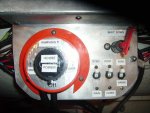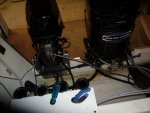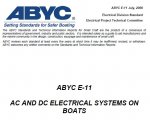Hi, I?m looking for some advice on how to wire up my boat?s electrical components. I have an 18? Duckworth Pro Steelheader II, which is a center console boat. It currently has a 1989 Yamaha 115/80 2 stroke jet motor on it. I currently have only one battery in the boat, which the outboard is hooked to for electric start. All electrical components are currently wired to the one battery. I have an On/Off perko switch, to cut all power to all components.
I will soon be purchasing an electric start kicker motor (most likely a Yamaha T9.9), as well as 2 Cannon Mag 10 stx electric downriggers. I?ll obviously need an additional battery as well. My question has to do with wiring all of this up in the ?best? way. Would it make sense to keep the main motor connected to the existing battery, with its existing perko switch, and then setup up the kicker motor, 2nd battery, and two electric downriggers with their own perko switch? Basically, two totally independent systems? I could then keep a set of jumper cables in the boat, in the event that I would need to jump start one of the batteries. Will the two electric downriggers do ok attached to one battery (being charged by the kicker), or would you suggest two additional batteries (1 downrigger per battery)? I will be installing a circuit breaker or fuse near the battery for each downrigger.
Any other suggestions as to how best to wire this all up? I?ve seen the BEP battery distribution clusters, as well as the Perko switches with the 1, 2, both, off settings. Would I be better off with the two independent electrical systems, or something like the BEP cluster?
Thanks,
Ken
I will soon be purchasing an electric start kicker motor (most likely a Yamaha T9.9), as well as 2 Cannon Mag 10 stx electric downriggers. I?ll obviously need an additional battery as well. My question has to do with wiring all of this up in the ?best? way. Would it make sense to keep the main motor connected to the existing battery, with its existing perko switch, and then setup up the kicker motor, 2nd battery, and two electric downriggers with their own perko switch? Basically, two totally independent systems? I could then keep a set of jumper cables in the boat, in the event that I would need to jump start one of the batteries. Will the two electric downriggers do ok attached to one battery (being charged by the kicker), or would you suggest two additional batteries (1 downrigger per battery)? I will be installing a circuit breaker or fuse near the battery for each downrigger.
Any other suggestions as to how best to wire this all up? I?ve seen the BEP battery distribution clusters, as well as the Perko switches with the 1, 2, both, off settings. Would I be better off with the two independent electrical systems, or something like the BEP cluster?
Thanks,
Ken
























